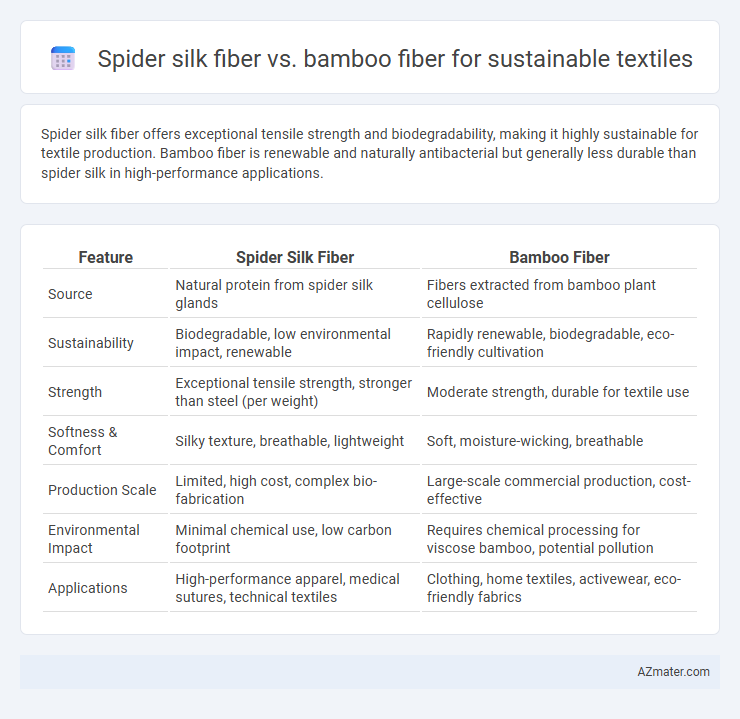Spider silk fiber offers exceptional tensile strength and biodegradability, making it highly sustainable for textile production. Bamboo fiber is renewable and naturally antibacterial but generally less durable than spider silk in high-performance applications.
Table of Comparison
| Feature | Spider Silk Fiber | Bamboo Fiber |
|---|---|---|
| Source | Natural protein from spider silk glands | Fibers extracted from bamboo plant cellulose |
| Sustainability | Biodegradable, low environmental impact, renewable | Rapidly renewable, biodegradable, eco-friendly cultivation |
| Strength | Exceptional tensile strength, stronger than steel (per weight) | Moderate strength, durable for textile use |
| Softness & Comfort | Silky texture, breathable, lightweight | Soft, moisture-wicking, breathable |
| Production Scale | Limited, high cost, complex bio-fabrication | Large-scale commercial production, cost-effective |
| Environmental Impact | Minimal chemical use, low carbon footprint | Requires chemical processing for viscose bamboo, potential pollution |
| Applications | High-performance apparel, medical sutures, technical textiles | Clothing, home textiles, activewear, eco-friendly fabrics |
Introduction to Sustainable Textiles
Spider silk fiber and bamboo fiber represent two innovative materials in sustainable textiles, each offering unique environmental benefits. Spider silk fiber is prized for its exceptional strength, biodegradability, and minimal resource requirements, making it a premium choice for eco-friendly textile production. Bamboo fiber stands out due to its rapid growth rate, natural antibacterial properties, and efficient land use, contributing to reduced water consumption and lower chemical input in sustainable fabric manufacturing.
Overview of Spider Silk Fiber
Spider silk fiber, derived from the natural protein produced by spiders, exhibits exceptional strength, elasticity, and biodegradability, making it a highly sustainable option for textile production. Unlike synthetic fibers, spider silk requires minimal water and energy for production, and its renewable nature reduces environmental impact significantly. Advanced bioengineering techniques now enable scalable spider silk fabrication, positioning it as a promising material for eco-friendly fashion and performance wear.
Overview of Bamboo Fiber
Bamboo fiber is a highly sustainable textile material derived from the fast-growing bamboo plant, known for its rapid renewability and minimal need for pesticides or fertilizers. It exhibits natural antimicrobial properties, breathability, and biodegradability, making it an eco-friendly alternative to conventional fibers. Compared to spider silk fiber, bamboo fiber is more accessible and cost-effective for large-scale textile production while maintaining a lower environmental impact throughout its lifecycle.
Production Processes: Spider Silk vs Bamboo
Spider silk fiber production relies on advanced bioengineering techniques where genetically modified organisms produce silk proteins that are then spun into fibers, while bamboo fiber extraction involves mechanical or chemical processes to break down bamboo pulp into textile fibers. The biofabrication of spider silk is energy-efficient with minimal chemical use, promoting a low environmental footprint through sustainable fermentation methods. Bamboo fiber production, especially in its mechanical form (bamboo linen), is eco-friendlier than viscose-based bamboo, but chemical treatments often increase pollution and energy consumption, affecting the fiber's overall sustainability.
Environmental Impact Comparison
Spider silk fiber exhibits exceptional biodegradability and minimal environmental footprint due to its natural production process without chemical inputs, significantly reducing pollution compared to synthetic fibers. Bamboo fiber, while also sustainable, requires intensive water and chemical treatments during processing that can contribute to water pollution and higher energy consumption despite its renewable growth cycle. The overall environmental impact favors spider silk fiber for sustainable textiles, given its lower resource use, reduced greenhouse gas emissions, and enhanced biodegradability.
Mechanical and Physical Properties
Spider silk fiber exhibits exceptional tensile strength, elasticity, and lightweight properties, making it one of the toughest natural fibers suitable for high-performance sustainable textiles. Bamboo fiber offers notable antibacterial properties, high moisture wicking, and breathability, though its tensile strength and elasticity are generally lower compared to spider silk. Both fibers provide eco-friendly alternatives, but spider silk's superior mechanical durability contrasts with bamboo's enhanced comfort and biodegradability in sustainable textile applications.
Biodegradability and End-of-Life Options
Spider silk fiber exhibits exceptional biodegradability, breaking down naturally in soil within months without releasing harmful residues, making it an ideal choice for sustainable textiles. Bamboo fiber, while also biodegradable, often undergoes chemical processing that can hinder its environmental performance and complicate end-of-life degradation. Spider silk's natural polymer structure supports closed-loop recycling and composting, whereas bamboo fibers are less compatible with such circular economy practices due to processing treatments.
Applications in the Textile Industry
Spider silk fiber offers exceptional strength, elasticity, and biodegradability, making it ideal for high-performance sportswear, medical textiles, and luxury apparel in sustainable fashion. Bamboo fiber provides natural antimicrobial properties, moisture-wicking, and rapid renewability, widely used in eco-friendly casual wear, activewear, and home textiles like towels and bed linens. Both fibers enhance sustainability in textiles by reducing reliance on synthetic materials and promoting environmentally responsible manufacturing processes.
Challenges and Limitations
Spider silk fiber faces scalability challenges due to difficulties in mass production and high costs associated with synthetic or farmed spider silk. Bamboo fiber, while renewable and biodegradable, often involves energy-intensive chemical processing that can generate harmful byproducts, limiting its environmental benefits. Both fibers encounter issues in consistent quality control and integration into existing textile manufacturing systems.
Future Prospects for Sustainable Fibers
Spider silk fiber offers exceptional strength, elasticity, and biodegradability, making it a promising sustainable textile material with potential applications in high-performance and eco-friendly fabrics. Bamboo fiber, known for its rapid growth, natural antibacterial properties, and renewable sourcing, provides an environmentally conscious alternative with lower water and pesticide requirements compared to conventional cotton. Future prospects for sustainable fibers emphasize innovations in bioengineering spider silk production and expanding bamboo fiber processing technologies to meet growing demands for sustainable, durable, and biodegradable textiles.

Infographic: Spider silk fiber vs Bamboo fiber for Sustainable textile
 azmater.com
azmater.com